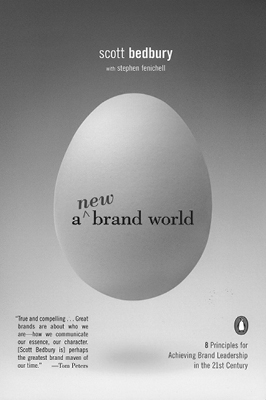A New Brand World
SCOTT BEDBURY WITH STEPHEN FENICHELL
Reviewed by Jack

Scott Bedbury was at the epicenter of the ascent of two of the most recognizable brands in the world. He was senior vice president of marketing at Starbucks from 1995 to 1998. During that period Starbucks had over 40 percent annual growth. Before Starbucks, he was head of advertising at Nike for seven years during the period in which the company changed its image radically. In A New Brand World, he offers insight into these classic brand creations and delivers a relevant book about brand building, brand extension, and brand loyalty. The book is heavily reliant on the Starbucks and Nike examples, but he also looks at other branding successes and failures.
Bedbury helped launch the “Bo Knows” and “Just Do It” campaigns. In rich detail, he relates stories of internal tension at Nike as it moved from its previous testosterone-heavy, “wimps need not apply” attitude to a brand with enough room for the entire family, and, ultimately, to the leading sports and fitness company. “Just Do It” became a brand that isn’t about sneakers or products but about values and ethos.
Bedbury went on to help create an actual brand definition for Starbucks, which, the year after he started, opened its first outlet outside the United States, in Japan. In a role that was much different than his previous one at Nike, he worked with Howard Schultz to create a brand code that helped define who Starbucks was. To do that he needed to gather intelligence, and to procure the intelligence, he used a three-pronged approach. First, he researched the product: coffee. He found that it was “. . . estimated that more than 3 billion cups of coffee were brewed around the world every day. Out of this, I figured that at least 2.7 billion of those cups sucked. In short, we faced a target-rich environment.” Then he learned as much as he could about the customer. Finally, he gained a clear understanding of where Starbucks stood in the marketplace by doing market research.
This rich information then allowed Starbucks to avoid brand extensions that were tempting but very wrong for the company. Bedbury explains that the “Starbucks brand’s core identity was less about engineering a great cup of coffee than about providing a great coffee experience,” and so they took pains to attend to that philosophy. Because Starbucks knew its brand so well, it realized that offering punch cards or volume discounts would not be in line with its commitment to the customer. “We wanted to reward our customers with consistently better service, not a sometimes cheaper cup of coffee,” says Bedbury. To dismiss a strategy most coffee companies use to compel customers to come back into stores might have been a mistake for another kind of company, but Starbucks knew its brand and its customers and made a choice that was unusual.
In addition to sharing his experiences working with these powerhouse brands, Bedbury teaches that every company should have one organizing principle: brand building. As opposed to looking at the brand as a message created by your marketing department, he believes brand building is a process that every part of the company must be centered around. As part of his eight universal principles of brand building, Bedbury lays out the core values that all brands should embody: simplicity, patience, relevance, accessibility, humanity, omnipresence, and innovation. Want a quick prescription for adding some humanity to your brand? Laugh at yourself; show genuine compassion; stand for something; listen and watch; admit your mistakes; find your soul; and become a more human employer.
“Relevance, simplicity, and humanity—not technology—will distinguish brands in the future.”
What I found particularly revealing about A New Brand World was Bedbury’s championing of two important aspects of brand—love and trust. Whether of a product or service, love and trust, he says, are crucial for brand building. Since the most aggressive advertising campaign cannot make a brand when a company or product lacks a soul or heart, both are required for marketing to resonate with consumers. Bedbury makes it clear that the best brands in fact started as great products or services. They don’t come out of the gate as great brands, but once a brand is chosen by the public, an opportunity exists for you to let the rest of the world know about it.
In most books written about or by entrepreneurial superstars, you can get a general feel for the leaders of world-class brands or perhaps a glimpse at an industry at one moment in time. What Scott Bedbury gives us in addition is an in-the-trenches look at brand creation. JC
A New Brand World: 8 Principles for Achieving Brand Leadership in the 21st Century, Penguin, Paperback 2002, ISBN 9780142001905
WHERE TO NEXT?
 Here for
brands in black and white
Here for
brands in black and white  Here for
using data across the organization
Here for
using data across the organization
 Here for
the case study in brand building |
EVEN MORE: Lovemarks by Kevin
Roberts; The Lovemarks Effect
by Kevin Roberts; Pour Your Heart Into It by
Howard Schultz and Dori Jones Yang
Here for
the case study in brand building |
EVEN MORE: Lovemarks by Kevin
Roberts; The Lovemarks Effect
by Kevin Roberts; Pour Your Heart Into It by
Howard Schultz and Dori Jones Yang